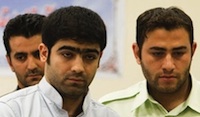 On 16 May 2012 The Times published a piece claiming that information found in an embassy cable released by WikiLeaks directly led to the execution of Majid Jamli Fashi, an Iranian kickboxer. Within hours, media outlets around the world picked up the article and the story went viral.
On 16 May 2012 The Times published a piece claiming that information found in an embassy cable released by WikiLeaks directly led to the execution of Majid Jamli Fashi, an Iranian kickboxer. Within hours, media outlets around the world picked up the article and the story went viral.
Nothing could have been further from the truth.
Once the Times published, the Daily Mail picked it up, Rupert's The Australian syndicated it, and then the Drudge got it, skyrocketing comments on Twitter.
The WikiLeaks twitter feed reacted swiftly and mercilessly. Spread over a succession of tweets:
Murdoch's Times tries to smear WikiLeaks for Iranian hanging. Media morons run with it without fact checking. The absolute contempt for the readers and the truth shows why there must be urgent reform. Let us consider the Iranian smear. We have: Wrong guy. This isn't the guy in the cable. Wrong publication. Spiegel, not WL, selected the cable, but anyway, it was redacted. Wrong country. Israel isn't even mentioned in the cable. In fact there's no connection whatsoever with the story other than it mentions martial arts. And yet dozens of 'press' outlets are running with it. Idiots! Wrong timeline. The guy (that the cable, as far as can be determined, has nothing to do with) was sentenced last August.
What seems to have happened is Rupert's journalist Martin Fletcher decided to research the background to the Fashi case, found a transplanted Alabama professor in Birmingham (Scott Lucas) who'd been following it, read a few of his articles from last year on the subject, and contacted him. Rupert's been keen to smear WikiLeaks for years, having failed at least twice before.
Lucas' article from 29 August 2011 refers to an embassy cable redacted by Spiegel Online and published simultaneously by WikiLeaks 3 December 2010, only a few days after the beginning of Cablegate.
C O N F I D E N T I A L SECTION 01 OF 02 BAKU 000687 E.O. 12958: DECL: 08/31/2019 TAGS: PGOV [Internal Governmental Affairs], PHUM [Human Rights], AJ [Azerbaijan], IR [Iran] SUBJECT: IRAN: NINJA BLACK BELT MASTER DETAILS USE OF MARTIAL ARTS CLUBS FOR REPRESSION; SAYS TABRIZIS "PRAGMATIC," CONFLICTED ON POST-ELECTION PROTESTS REF: A) BAKU 575 Classified By: POL/ECON COUNSELOR ROB GARVERICK, REASON 1.4 (B and D) Iranian Martial Arts Clubs Used for Political Repression
The cable went on to tell the story of XXXXXXXXXXXX, a licenced martial arts coach and trainer from Tabriz who was in Baku at the time, possibly for the martial arts tournament being held there (which Fashi also attended). XXXXXXXXXXXX told the embassy contact (for reasons unknown) that private martial arts clubs in Iran were under 'intense pressure' to cooperate with Iranian intelligence and Revolutionary Guard organisations and had even been involved in contract killings.
XXXXXXXXXXXX, who otherwise held classes in Taekwondo, was en route to Japan at the time. (Fashi was a kickboxing coach.)
Lucas was aware of the cable and speculated that XXXXXXXXXXXX might in fact be the condemned Fashi, despite the martial arts categories not matching and despite nothing else adding up save the fact both XXXXXXXXXXXX and Fashi may have been in Baku at the same time.
In September 2009, an Iranian political source - who also happens to be trained in martial arts - tells the US Embassy in Azerbaijan that the regime is pressuring martial arts clubs, despite suspicions that they could be assisting opposition groups, to provide instruction for the Ministry of Intelligence and the Revolutionary Guards.
The outcome supposedly went beyond training: the source maintains that one of his acquaintances killed at least six intellectuals and young "pro-democracy activists" before he himself was eliminated.
Guess where the US Embassy that posted the report was located? Baku in Azerbaijan.
Lucas is one of two sources the article in The Times cites. The other offered only a colour quote. Lucas asks in conclusion:
So was Jamali Fashi the source? Was he named by the source?
The Lucas article was published 29 August 2011. 'Cablegate2' began only three days later on 1 September, after which a full unredacted copy of 09BAKU687 appeared online. The identity of XXXXXXXXXXXX was revealed at that time and it wasn't Fashi. But this fact went unnoticed by Lucas and Martin Fletcher of The Times.
Majid Jamali Fashi, 24, was arrested one month after the unauthorised publication of a cable from the embassy, in Azerbaijan, which described one of its sources as an Iranian martial arts expert. Mr Fashi had visited Azerbaijan the previous month for a kick-boxing tournament.
Fashi was indeed arrested in January 2011 along with nine others believed to be part of the same cell. The Iranian authorities stated that the cell was infiltrated by a 'third country' that turned over the information to them. At no time have the Iranian authorities mentioned any embassy cable in connection with the case.
UPDATE 2012-05-18: Scott Lucas has published a new article which reevaluates the role of WikiLeaks in the controversy.
... Jamali Fashi was not the person who spoke to the Americans. Indeed, given that the source had left Iran in mid-July, with the aim of getting a visa for a foreign country, it is unlikely that he had any connection with the kickboxing team that was in Azerbaijan.
Theme by Danetsoft and Danang Probo Sayekti inspired by Maksimer